The night sky is a sight to behold, with its glittering stars and mysterious planets. But when it comes to brightness, not all stars are created equal. From dim to dazzling, here are the top ten brightest stars in the night sky, ranked from 10 to 1.
10- Betelgeuse
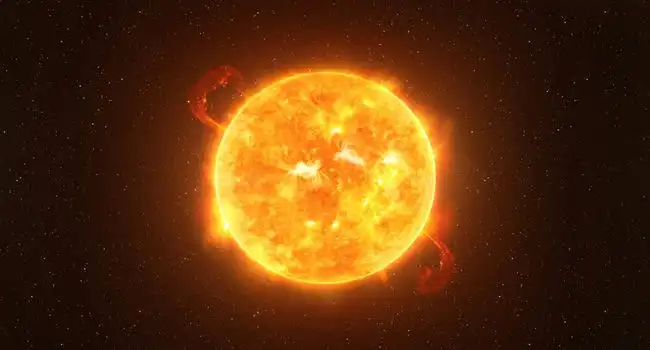
Photo Credit: Deccan Herald
Betelgeuse is the tenth brightest star in the night sky. It is located in the constellation of Orion. It is a red supergiant star, approximately 550 light-years from Earth. Betelgeuse has a mass of around 10-20 times that of our sun and it is around hundred times its size. Its diameter is estimated to be about 1.2 billion km. Betelgeuse is an irregular variable star, whose brightness can vary from 0.2 to 1.2 magnitudes. It is a highly luminous star, capable of producing energy at a rate of up to 100,000 times that of our Sun.
Its surface temperature is estimated to be around 3,500K. Betelgeuse is a young star, with an age of only 10 million years. Its core is composed of mostly hydrogen and helium, with a small amount of heavier elements. Betelgeuse is moving away from us at a speed of around 19 km/s. It is expected to eventually explode as a supernova, releasing a huge amount of energy. This event is likely to occur within the next thousand years.
9- Achemar
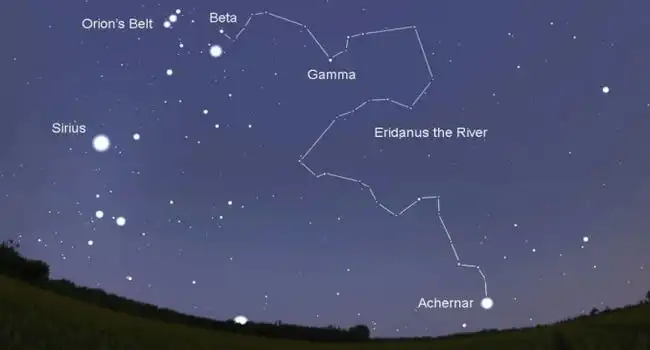
Photo Credit: Astronomy Trek
The night sky is filled with countless stars, each one unique in its own way. The brightest stars, such as Achemar, shine brighter than the rest. Its luminosity is about 2,000 times brighter than the Sun. Achemar is about 260 light-years away from Earth and belongs to the constellation Eridanus. It is one of the hottest stars known, with a temperature of about 12,000 Kelvin. It is classified as a Be-type blue star, and is considered to be a giant star.
This giant star is about 10 times larger than the Sun and is nearing the end of its life. Achemar is also known to be one of the most luminous stars in the Milky Way Galaxy, radiating more energy than the Sun. It is an incredibly beautiful sight to behold in the night sky, and any astronomer can easily spot it. Achemar is a star that will continue to astound us for many years to come.
8- Procyon

Photo Credit: In The Sky
Procyon is the 8th brightest star in the night sky and the brightest in the constellation Canis Minor. It is a binary star system located 11.4 light-years from Earth. Its primary component is a white main-sequence star that has a temperature of around 7500 K. Its secondary component is a faint red dwarf star. Procyon has twice the mass and radius of the Sun, and is about 55 million years old. It is a relatively young star and is still in the process of burning its hydrogen fuel. It will eventually evolve into a red giant.
Procyon is surrounded by a circumstellar disk of gas and dust, which is slowly dissipating. Procyon is believed to be the source of infrared excess in the system, indicating that it is a relatively young star still in the process of formation. It is also known to emit X-rays, which are believed to be generated by its active corona. Procyon is a bright, hot star and is visible to the naked eye, even from moderately light-polluted areas. It is a great target to observe through a telescope, and its binary nature makes it an interesting object for study.
7- Rigel

Rigel is the brightest star in the constellation of Orion. It is a blue-white supergiant, located some 860 light-years away. Rigel is estimated to be 100,000 times brighter than the Sun. Its temperature is estimated to be between 11,000 and 12,000 K. It is so powerful that its light can be seen from over 860 light-years away. Rigel is a double star, with a companion star, Rigel B, orbiting it at a distance of 0.06 AU. The two stars are separated by approximately 7.5 arcseconds.
Rigel is believed to be around 10 million years old and is thought to be on its way to becoming a supernova. Rigel is visible in the night sky, and is often used as a navigational aid. Its brightness means it is a very useful star for amateur astronomers. Its position in the night sky also means it can be used to identify the constellation of Orion. Rigel is an important star, both scientifically and culturally, and will continue to inspire generations to come.
6- Capella

Capella is the brightest star in the Auriga constellation. It is the sixth brightest star in the night sky and the third brightest star in the northern hemisphere. Capella is a yellow-white supergiant star, about 10,000 times brighter than the Sun. It is located at a distance of about 42 light-years from Earth. This star is about 12 times bigger than the Sun in size and has a mass of about 20 solar masses. Capella is a double-star system, consisting of two giant stars that orbit each other at a distance of about 0.1 Astronomical Units.
The two stars are of different sizes and temperatures, with one being a G-type giant and the other an A-type giant. Capella is believed to be about 500 million years old. It is a very stable star and does not vary in brightness or color from one day to the next. Capella is a prominent landmark in the night sky and can easily be seen in the northern hemisphere. It is a great star to observe through a telescope, as it is bright and well-resolved. It is a great source of fascination and awe for amateur astronomers.
5- Vega
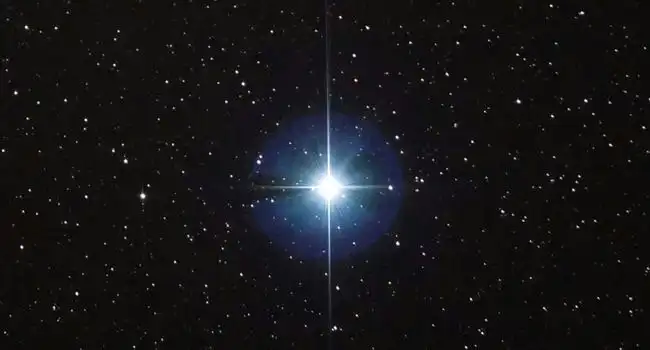
Photo Credit: Tech Explorist
Vega is one of the brightest stars in the night sky. It is a blue-white star located in the constellation Lyra. It is the fifth brightest star in the sky and the second brightest star in the northern hemisphere. Vega is around 25 lightyears away from Earth. It is the brightest star in the northern hemisphere and is easily visible in the night sky. The star is about 2.5 times the mass of the Sun and around twice its size. It has a temperature of around 9,500 degrees Celsius, making it one of the hottest stars in the sky.
Vega is around 460 million years old and is expected to remain visible for around another 300 million years. It is a rapidly rotating star, spinning around its axis once every 12.5 hours. Vega emits around 40 times more energy than the Sun. It is also the brightest star in the Lyra constellation and is the anchor point for the Summer Triangle asterism. The star is easily visible during the northern hemisphere summers and is one of the most recognizable stars in the night sky.
4- Arcturus
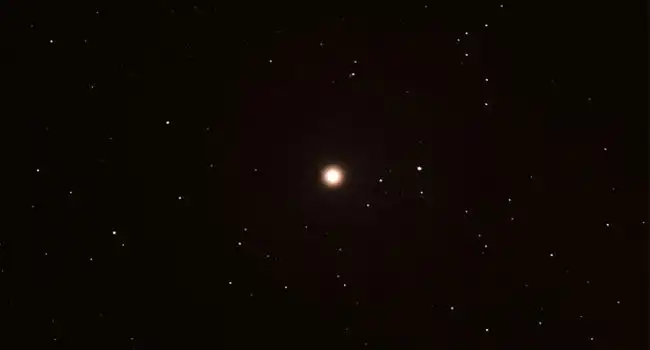
Arcturus is the brightest star in the Northern Hemisphere. It is a red giant located in the constellation Bootes. It is 36.7 light years away from Earth. Its name is derived from the Greek word ‘arktos’, meaning bear. Its visual magnitude is -0.05, making it one of the brightest stars in the night sky. It is approximately 25 times the size of our Sun, and 170 times its luminosity. Arcturus is around 4 billion years old, and is about to enter its red giant phase.
Its temperature is around 4100K, giving it a reddish hue. It is classified as an orange-red star, and its spectral type is K1.5 IIIpe. Arcturus has a mass of 1.1 solar masses and is estimated to be 25 times the size of our Sun. Its rotational velocity is 14 km/s. It is believed to have at least one orbiting companion star. Arcturus is a source of X-ray emission, and is a relatively strong source of radio waves. It is an important navigational star, and is the fourth brightest star in the night sky.
3- Rigil Kentaurus & Toliman
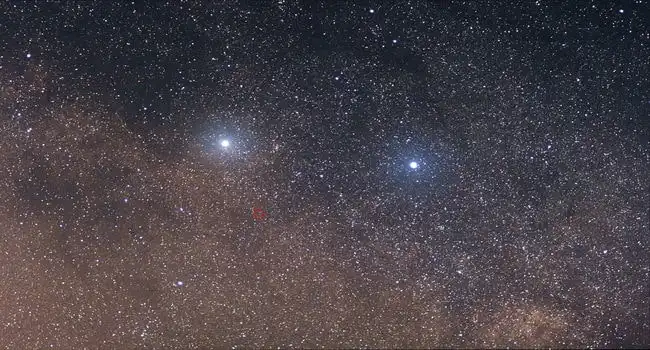
Rigil Kentaurus, also known as Alpha Centauri A, is the brightest star in the constellation Centaurus. It is approximately 4.37 light-years away from Earth. Toliman, also known as Alpha Centauri B, is the second brightest star in the constellation. It is located 4.35 light-years away from Earth. Together, they are known as the closest star system to our own solar system. Rigil Kentaurus is a yellow-white star, similar to our own Sun, while Toliman is an orange-red dwarf star. Both stars are visible from Earth without the use of a telescope. They appear as a single point of light in the night sky and are often referred to as the “Southern Pointer Stars”. Together, they form a binary star system, with each star orbiting the other every 79.9 years. The two stars are held together by the force of gravity, making for a spectacular sight in the night sky.
2- Canopus

Canopus is the brightest star in the night sky. It is located in the constellation Carina, about 310 light-years from Earth. Canopus is an Alpha Carinae type star, which is a supergiant that is about 10 times the size of our Sun. It is estimated to be about 10,000 times brighter than our Sun. Canopus is so bright that is can be seen even in areas with light pollution. It has been used by sailors to help them navigate since ancient times.
Canopus is a blue-white star, and it has a temperature of about 7400 kelvins. It is believed to be around 12 million years old. Canopus is a pulsating variable star and its brightness can vary by a few tenths of a magnitude. It is also part of an asterism known as the False Cross, which is formed by four stars including the stars Ankaa, Aspidiske, and Suhail. Canopus is a very important star in the night sky and it can be seen from all over the world.
1- Sirius
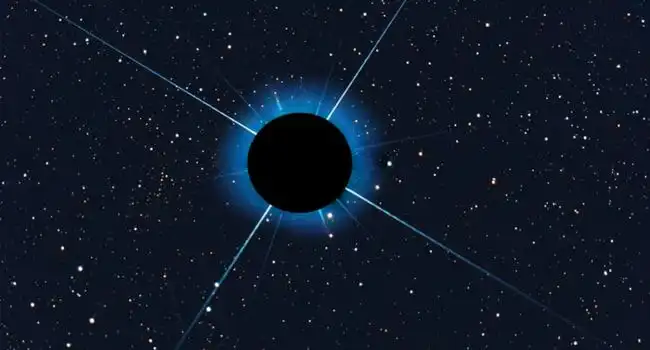
Photo Credit: Universe Today
Sirius is the brightest star in the night sky. It lies 8.6 light years from Earth in the constellation of Canis Major. It is 25 times brighter than our Sun and twice as massive. Sirius is also known as the Dog Star due to its location in Canis Major. It is a binary star system, composed of a white main-sequence star and a faint white dwarf companion. Sirius A is the brightest star in the night sky and has a luminosity of 23 times that of our Sun.
It has a temperature of 9,940K and a diameter of 1.7 times that of our Sun. Sirius B is a faint white dwarf companion that orbits Sirius A. It has a temperature of 25,200K. The two stars orbit each other every 50.1 years. Sirius is a great source of inspiration for many cultures and is even used as a navigation tool by sailors. It is a symbol of hope, courage and strength and is a reminder of the beauty and mystery of the night sky.


